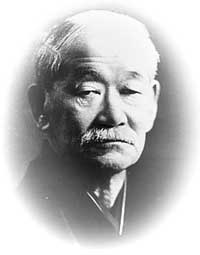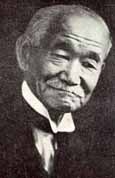by Jigoro Kano
Many martial arts were practiced in Japan during its feudal age: the use of the lance, archery, swordsmanship and many more. Jujutsu was one such art. Also called taijutsu and yawara, it was a system of attack that involved throwing, hitting, kicking, stabbing, slashing, choking, bending and twisting limbs, pinning an opponent, and defenses against these attacks. Although jujutsu’s techniques were known from the earliest times, it was not until the latter half of the sixteenth century that jujutsu was practiced and taught systematically. During the Edo period (1603-1868,) it developed into a complex art taught by the masters of a number of schools. In my youth I studied jujutsu under many eminent masters. Their vast knowledge, the fruit of years of diligent research and rich experience, was of great value to me. At that time, each man presented his art as a collection of techniques. None perceived the guiding principle behind jujutsu. When I encountered differences in the teaching of techniques, I often found myself at a loss to know which was correct. This led me to look for an underlying principle in jujutsu, one that applied when one hit an opponent as well as when one threw him. After a thorough study of the subject, I discerned an a1l-pervasive principle: to make the most efficient use of mental and physical energy. With this principle in mind, I again reviewed all the methods of attack and defense I had learned, retaining only those that were in accordance with the principle. Those not in accord with it I rejected, and in their place I substituted techniques in which the principle was correctly applied. The resulting body of technique, which I named judo to distinguish it from its predecessor, is what is taught at the Kodokan. The word jujutsu and judo are each written with two Chinese characters. The ju in both is the same and means “gentleness” or “giving way.” The meaning of jutsu is “art, practice,” and do means “principle” or “way,” the Way being the concept of life itself. Jujutsu may be translated as “the gentle art,” judo as “the Way of gentleness,” with the implication of first giving way to ultimately gain victory. The Kodokan is, literally, “the school for studying the Way.” As we shall see in the next chapter, judo is more than an art of attack and defense. It is a way of life. To understand what is meant by gentleness or giving way, let us say a man is standing before me whose strength is ten, and that my own strength is but seven. If he pushes me as hard as he can, I am sure to be pushed back or knocked down, even if I resist with all my might. This is opposing strength with strength. But if instead of opposing him I give way to the extent he has pushed, withdrawing my body and maintaining my balance, my opponent will lose his balance. Weakened by his awkward position, he will be unable to use all his strength. It will have fallen to three. Because I retain my balance, my strength remains at seven. Now I am stronger than my opponent and can defeat him by using only half my strength, keeping the other half available for some other purpose. Even if you are stronger than your opponent, it is better first to give way. By doing so you conserve energy while exhausting your opponent. This is but one example of how you can defeat an opponent by giving way. It was because so many techniques made use of this principle that the art was named jujutsu. Let us look at a few other examples of the feats that can be accomplished with jujutsu. Suppose a man is standing before me. Like a log on end, he can be pushed off balance — frontward or backward — with a single finger. If at the moment he leans forward, I apply my arm to his back and quickly slip my hip in front of his, my hip becomes a fulcrum. To throw the man to the ground, even if he greatly outweighs me, all I need do is twist my hip slightly or pull on his arm or sleeve. Let us say I attempt to break a man’s balance to the front, but that he steps forward with one foot. I can still throw him easily by merely pressing the ball of my foot just below the Achilles’ tendon of his advancing leg a split second before he places his full weight on that foot. This is a good example of the efficient use of energy. With only slight effort, I can defeat an opponent of considerable strength. What if a man were to rush up and push me? If instead of pushing back, I were to take hold of his arms or his collar with both hands, place the ball of one foot against his lower abdomen, straighten my leg and sit back, I could make him somersault over my head. Or suppose that my opponent leans forward a bit and pushes me with one hand. This puts him off balance. If I grab him by the upper sleeve of his outstretched arm, pivot so that my back is close to his chest, clamp my free hand on his shoulder and suddenly bend over, he will go flying over my head and land flat on his back. As these examples show, for the purpose of throwing an opponent the principle of leverage is sometimes more important than giving way. Jujutsu also includes other forms of direct attack, such as hitting, kicking and choking. In this respect, the “art of giving way” does not convey the true meaning. If we accept jujutsu as the art or practice of making the most efficient use of mental and physical energy, then we can think of judo as the way, the principle, of doing this, and we arrive at a true definition. In 1882 I founded the Kodokan to teach judo to others. Within a few years, the number of students rapidly increased. They came from all over Japan, many having left jujutsu masters to train with me. Eventually judo displaced jujutsu in Japan, and no one any longer speaks of jujutsu as a contemporary art in Japan, although the word has survived overseas.
This article is an excerpt from Kodokan Judo by Jigoro Kano. This award winning web page is provided by Neil Ohlenkamp, Judo Information Site, USA. Copyright © 1997/2003. Last modified April 21, 2003. |

 Most people are no doubt familiar with the words jujutsu and judo, but how many can distinguish between them? Here, I will explain the two terms and tell why judo came to take the place of jujutsu.
Most people are no doubt familiar with the words jujutsu and judo, but how many can distinguish between them? Here, I will explain the two terms and tell why judo came to take the place of jujutsu.
